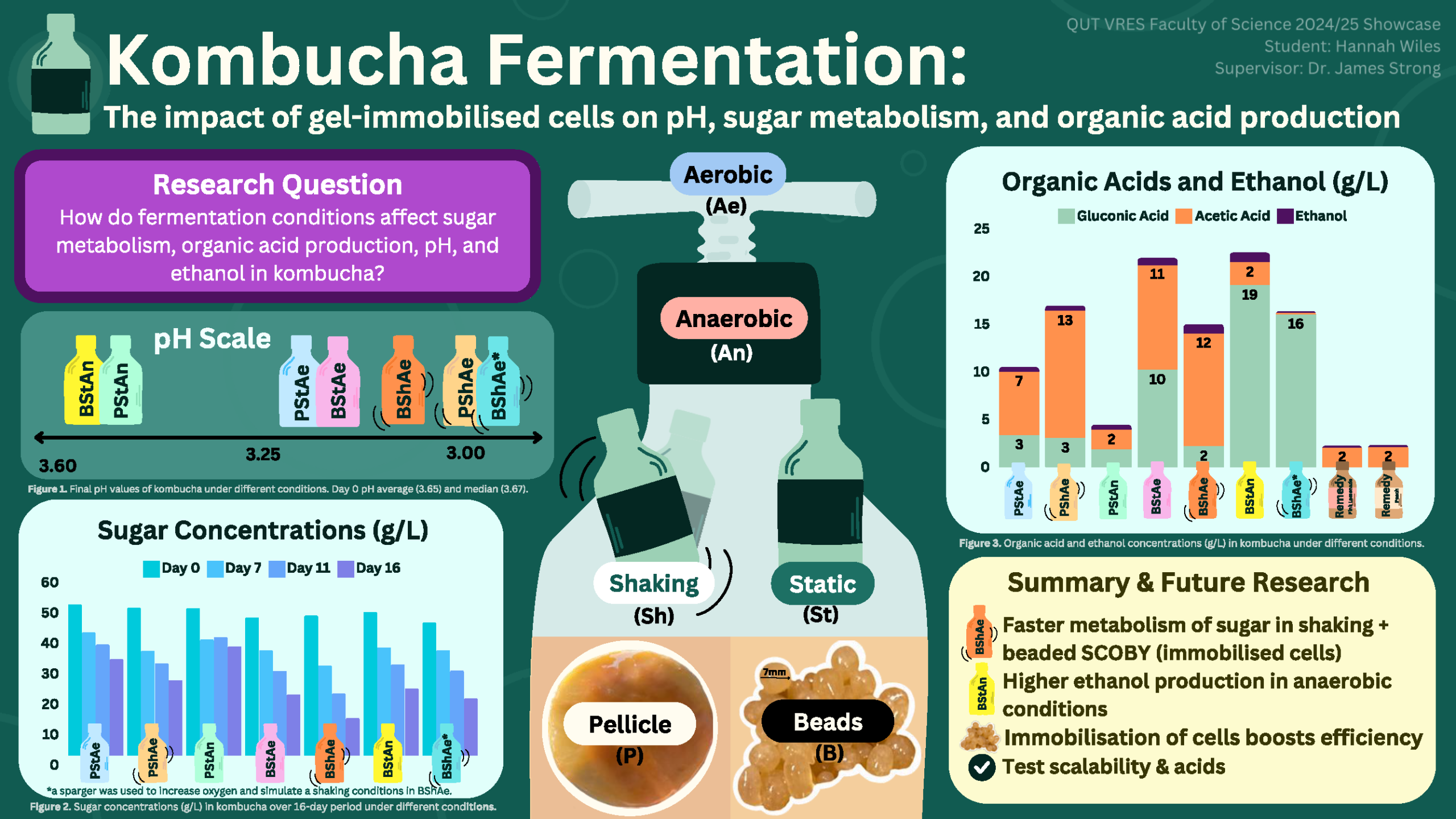Kombucha Fermentation: The impact of Gel-Immobilised Cells on PH, Sugar Metabolism, and Organic Acid Production
Hannah Wiles
Supervisor: Dr James Strong
Kombucha is a fermented tea produced by a symbiotic culture of bacteria and yeast (SCOBY). While traditionally grown as a floating pellicle, alternative fermentation conditions such as shaking, immobilisation in alginate beads, and variations in oxygen availability (aerobic vs. anaerobic) may influence microbial activity, sugar metabolism, and organic acid production. Understanding how these factors influence chemical composition is important in optimising fermentation.
Despite research on kombucha’s microbial composition, limited studies have explored how specific cultivation conditions affect fermentation outcomes. This study investigates the impact of different conditions; including static vs. shaking incubation, alginate-immobilised vs. free-floating pellicle SCOBY, and aerobic vs. anaerobic environments on pH, ethanol, sugar metabolism, and organic acid production over a 16-day period.
Kombucha was aseptically prepared using Tetley black tea and raw sugar. A SCOBY was blended and equally divided among pellicles and biomass immobilised in alginate gel beads. The SCOBYs were acclimated under identical conditions for two weeks and then used to inoculate new media (identical) but fermented under seven conditions. Flasks were incubated at ambient room temperature (~24°C), and pH was recorded at multiple time points. Samples were collected, frozen at -20°C, and thawed before analysis. A sucrose standard curve was prepared using tea-infused water and a refractometer was used to measure sucrose sugar content. High-performance liquid chromatography was used to quantify organic acid concentrations.
Preliminary results indicate that fermentation conditions significantly impact both pH trends and sucrose consumption. pH profiles showed a consistent decline across all conditions, with faster acidification observed in samples with immobilised cells under shaking conditions. Interestingly, the alginate immobilised biomass consumed sucrose faster than the pellicle SCOBYs, likely as a result of greater surface area from the circular beads. The two static pellicle samples (aerobic and anaerobic) were the slowest sucrose consumers, while the third slowest was the shaking aerobic pellicle sample. Among the immobilised cultures, the static-anaerobic, static-aerobic and sparged-aerobic cultures clustered together. Surprisingly, the shaking-aerobic bead cultures consumed sucrose more rapidly than the sparged-bead culture – indicating that the excess oxygen did not result in increased sugar consumption.
These initial observations highlight the fermentation dynamics between a SCOBY microbial consortia, indicating the potential of immobilised cells for improved sugar metabolism and acid production. Further research is needed, and would include detailed analyses with multiple samples and benchmarking against commercially-available products. Preliminary results indicate that immobilised bead cultures may be a viable alternative to increase the kinetics of kombucha production, or lower the reactor volumes to generate an equivalent product yield relative to traditional fermentation reactors.
Media Attributions
- Kombucha Fermentation: The impact of gel-immobilised cells on PH, sugar metabolism, and organic acid production © Hannah Wiles is licensed under a CC BY-NC (Attribution NonCommercial) license


